How to choose an electric heated towel rail and properly connect it
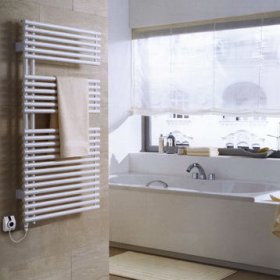
When the heating period ends, there are problems with drying the towels in the bathroom, because the heated towel rail also becomes cold. So that every time after taking a shower you do not have to hang towels on the balcony, many owners change the traditional water model to electric heated towel rail For bathroom. It works all year round, is not connected with the heating system and is much easier to install. We will figure out what types of electric heating devices exist, how they are good, and how to properly connect the device in the bathroom.
Content
Types of models for internal filler
The advantage of electric models in comparison with water models is a closed circuit. Those. the device works completely autonomously, regardless of whether there is hot water in the house or not. In such systems there are no air jams, problems with pressure. The only danger is if the lights are turned off for a long time. True, power outages are usually resolved during the day, while maintenance work with water pipes can last all summer.
Today, two types of towel warmers have been developed, depending on the internal filling of the pipes. The so-called "wet" and "dry" options. In the “wet” heating occurs the same way as in a conventional heater: a liquid circulates inside the housing, heated from below by a heating element. Most often, pipes are filled with antifreeze or oil.
In “dry”, instead of liquid, there is a heating cable similar to those mounted in the system “warm floor».
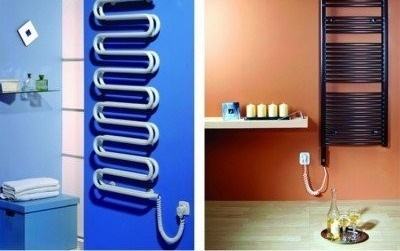
According to the originality of the design, cable types of heated towel rails are much more diverse than liquid ones, because they are not tied to the heating element, which must be at the bottom of the structure
Compare the technical characteristics of both types:
- Cost. Cable is cheaper, because it does not require increased tightness, like fluid-filled models.
- Installation. Installation of cable heated towel rails is easier, because there is no heating element, which must be located at the bottom of the case. Those. "Dry" can be hung at least diagonally, and "wet" - only upright.
- Power. In terms of power, liquid models are much stronger than cable ones. As a rule, “dry” heated towel rails consume no more energy than a 100 W bulb. But at the same time, the level of heating will be weaker.
- Power consumption. “Wet” systems can produce power up to 2 thousand watts and, of course, consume a lot of energy. Oriented as follows: if the device is needed purely for drying towels, then take the cable option. And if the bathroom will also be heated in the winter due to a heated towel rail, it is better to stay on the heating model.
- The level of heat conservation. The heating rate is higher for cable devices, because the liquid still needs time to “swing”. But the “dry” ones also instantly cool down, and when disconnected from the mains, antifreeze or oil will give off heat for a long time.
- The ability to adjust the heating temperature. Additional elements such as multi-stage temperature control are more often introduced into TEN heated towel rails, because the liquid is able to heat up to very high temperatures. Therefore, the owners themselves set the level at which the device will warm up. Cable systems are equipped with this function much less frequently. Basically, these are models that operate on the principle of "plug and forget."
You may also be interested in material that describes the installation and connection of heated towel rails:https://aquatech.tomathouse.com/en/santehnika/polotencesushitel/ustanovka-i-podklyuchenie-polotencesushitelya.html.
The choice of the device in appearance and place of installation
Now we will figure out how to choose an electric heated towel rail in appearance. The traditional “coil” model in the form of a curved tube is annoying consumers, because it does not always fit into the style of the room. But the lineup has already expanded significantly, and there are models on sale that resemble ladders, geometric shapes and other interesting shapes.
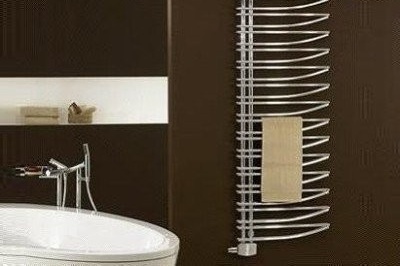
The convex shape of the tubes in the electric heated towel rail is convenient for hanging small items, and the stylish design fits the modern bathroom interior
A few tips:
- Pay attention to the number of horizontal tubes. The more of them, the higher the heat transfer.
- Convex tubes are convenient in that they hang laundry well for drying.
- Towel dryers with sliding side “ears” are in special demand in small-sized rooms. Those. only the central part of the device is stationary mounted on the wall, and 2 or one side move like doors in lockers. If you need to dry a lot of linen - they are opened, if not - fold to the center.
If the bathroom is crowded, then it’s worth picking up the model immediately with a shelf where you can place fresh towels or hygiene items.
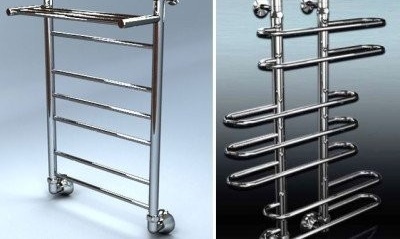
An electric heated towel rail with a shelf saves space in the bathroom by simultaneously acting as a heater and stand for storing hygiene items
When analyzing models, they pay attention to the mobility of the design. Some devices are designed to be installed only on the wall, and the second - floor. Wall options take up much less space, but they cannot be moved if necessary to the kitchen or to the veranda. Floor-standing are advantageous in that they do not require drilling walls and hanging additional accessories on which the structure will hang. They are equipped with legs for stable fixation on the floor. It remains only to connect the plug to the outlet.
Selecting the unit for the required power
When choosing a specific model, it should be borne in mind that the most powerful electric heated towel rails are not always the best. The excessive consumption of energy will affect the payment of bills, so it is more profitable to select the device exactly according to the volume of the room. For example, for rooms they calculate power so that per 1 sq.m. accounted for 100 watts of energy. In this case, the heating temperature will be approximately 18 degrees.
Such heat is not enough for a bathroom, because in high humidity the body is much more sensitive to cold. Therefore, experts consider 140 W per 1 sq.m. to be the optimal figure. This is provided if your heated towel rail will heat the room, and not just dry wet towels! As a result, for a bathroom of 4 sq.m. need a model with a power of 140 X 4 = 560 watts. Devices with less power will not be able to warm the room to 22-24 degrees. But if you need a system exclusively for the spring-summer period, then low-power cable electric towel warmers are quite suitable, and repairing them in case of breakdowns will be cheaper.
In our next material, an instruction manual with calculations for making a heated towel rail with your own hands is presented:https://aquatech.tomathouse.com/en/vodosnab/polotencesushitel-svoimi-rukami-eto-prosto-17.html.
Basic installation and connection rules
Since electric heated towel rails do not require a tie-in into the water supply system, their connection is much simpler than with water devices. The only nuance that must be taken into account comprehensively is the maximum insulation of electricity. In wet conditions, any current leakage is a serious life threat. Therefore, the issue of security during installation of the system is one of the main ones. Be sure to check the quality of the wiring to which the wires will be connected. During the installation, grounding is made and an RCD is connected, which will become a protection for the heated towel rail during power surges.
Option # 1 - Connect to a power outlet in the bathroom
There are two options for connecting the device:
- to the outlet that is in the bathroom;
- to an outlet outside the bathroom.
The first option is used if the heated towel rail is not equipped with a thermostat that turns off the device when a certain temperature is reached. In this case, in order not to waste energy, just unplug the plug when not using the bath.
Sockets with a moisture-proof housing are suitable for this room. Cable connections to them are made either from the bathroom fixture, or from another room. In any case, the wires should be hidden in the gate, and the outlet itself should be recessed into the wall as much as possible and equipped with a cover for insulation.
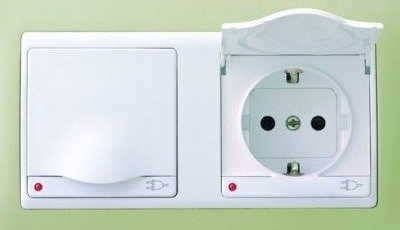
The socket for connecting a heated towel rail should have a moisture cover and rubber seals that prevent the passage of vapors through the plug holes
Another caveat - you can not put the outlet on the wall, which is in contact with the street. Condensation may cause short circuits. It is better that the wall goes into the corridor.
Option # 2 - outlet outlet outside the bathroom
A more correct installation method is with the outlet of the outlet outside the wet room. This is especially true for those owners who like to bask in the bathroom for a long time, and not be content with a shower.
To do this, a hole puncher is drilled in the wall into the room where the outlet will be located. Most often it is a kitchen. If it is necessary to lay the cable in the bathroom itself, then it is lifted above the floor (10 cm or more). This is necessary so that in the event of a flood, water does not arrange a wiring closure.
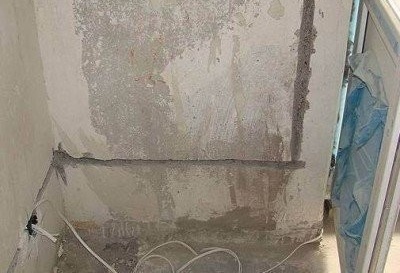
To increase the safety of the room, the cable is placed in the wall above 10 cm from the floor, so that during a flood it does not get exposed to water
Well, if the heated towel rail is already installed and has been working for a long time, but there are malfunctions, the following article will help you, which describes the main problems and their solutions:https://aquatech.tomathouse.com/en/otoplenie/radiatory/ne-greet-polotencesushitel-vse-prichiny-i-varianty-resheniya-problemy.html
To connect a heated towel rail, you should invite a professional electrician, because moisture and current are incompatible things. Better to prevent a problem than to suffer from an illiterate installation.
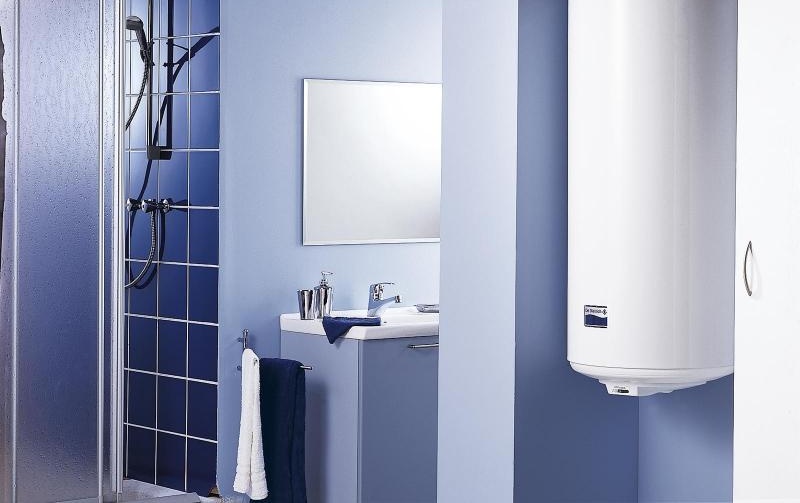

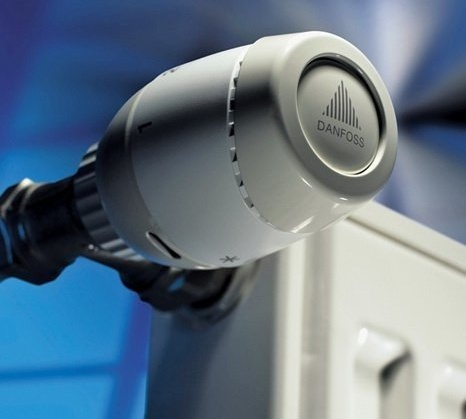
3 comments